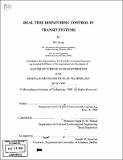Real time dispatching control in transit systems
Author(s)
Song, Wei, 1970-
DownloadFull printable version (9.325Mb)
Advisor
Nigel H.M. Wilson.
Terms of use
Metadata
Show full item recordAbstract
Maintenance of reliable service is a goal of any rail transit agency. Reliability is difficult to maintain due to the perturbations that serve to disrupt headway sequences. These incidents that affect the service quality of transportation agencies can be categorized into two types, major disruptions and minor disturbances, based on their nature and causes. To maximize the capacity of a rail transit line and avoid busing, single track operation is analyzed in this thesis to deal with major disruptions. Based on the tracks and crossover configuration of the Massachusetts Bay Transportation Authority Red Line, a full analysis of possible strategies is presented which might form the basis for a major disruption response system. This could take the form of pre-planned short term operation plans which would be geared to the type, location and time of day of the disruption. The dispatching problem occurs around a terminal when a train is not expected to arrive at the terminal early enough to be dispatched on its next trip on schedule. This problem can be considered as a special case of minor disturbance. Its solution can also supply insight into the more general minor disturbance problem. We use holding and short turning as our control strategies to deal with the dispatching problem. Choosing minimizing passenger waiting time or the number of overcrowded trains as the objective, a heuristic dispatching control model is designed and evaluation and simulation models are used to estimate and compare the effectiveness of the current dispatching system and the heuristic dispatching control model. The results show that the heuristic dispatching control model could produce savings in average passenger waiting time of up to 14%, with the effectiveness increasing as the disruption becomes more severe. As part of this research, a dwell time model is estimated for Red Line trains in order to predict the running time of a train to help select the appropriate control strategy.
Description
Thesis (S.M.)--Massachusetts Institute of Technology, Dept. of Civil and Environmental Engineering, 1998. Includes bibliographical references (leaf 131).
Date issued
1998Department
Massachusetts Institute of Technology. Department of Civil and Environmental EngineeringPublisher
Massachusetts Institute of Technology
Keywords
Civil and Environmental Engineering